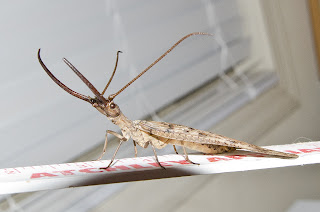1. Well Ms. Lory, it's another consequence of my motion sickness. This is my eye. I got car sick and ended up bursting a capillary in my eye. Blood is a special kind of connective tissue. Connective tissues support and hold together other tissues, and transport nutrients. Connective tissue cells are found in a mixture secreted by the cells (extracellular material). Even though blood has some different functions than other connective tissues, such as tendons and cartilage, it does have the extracellular material.
2. This is a bunny that was in an environmentally protected area on my street. It was feeding on the grass and sat and watched us but then ran back into the brush. A niche is the relationship of a species in his ecosystem. His niche includes the biotic and abiotic factors he needs to survive.
3. This is a butterfly in my backyard. A butterfly is an example of a pollinator. Pollinators are crucial in plant reproduction. They carry the pollen from the male part of the flower to the female part of the same or a different flower. Last week was NATIONAL POLLINATORS WEEK!
4. The lighter areas in this picture are of lichen.
A lichen is actually not one organism but an example of mutualism of a fungus
an alga or cyanobacteria. It is classified as a fungus because that is the
major part. I think this is lichen is Xanthoparmelia and the other darker part is a
moss.
Because they absorb water easily, lichens can
survive in harsh environments. They are
sensitive to air pollution so they are used to map concentration of pollutants
and they play a part in forming soil. They are also harvested for food for
reindeer by people above the Arctic Circle.
5. This picture shows two different types of ferns (you can
also see lichens). There are about 10,500 species of ferns and they can be from
2 inches tall to 30 feet. Ferns don’t
have leaves, they have fronds. They produce spores on the underside of the fronds
that harden and fall to the ground. They germinate to produce new plants.
6. Tropism is when an organism bends toward or away from a
stimulus like light, heat, or gravity. The response can be positive or
negative. For example when a seed germinates it is called negative geotropism
because it is growing against gravity.
These are Wave Petunias in my back yard. You can see that
they have grown to one side. This is an example of a type of tropism called
phototropism and it is positive because it is growing towards the light. Auxins
are plant hormones and they are involved in the growth of the cells in the
plant. The sunlight gets rid of the auxin in the cells on the sunny side of the
plant, so more cells are produced on the side in the shade and they are also
elongated. This makes the plant bend towards the sun.
7. This squirrel was looking for food in the same area as the
rabbits. He is a hetertroph, which means he can’t produce his own food and is
dependent on organic materials from other organisms for energy. That makes him
a consumer in the food chain.
8. Radial symmetry in an animal is when their body parts are
arranged around a central axis. They don’t have a right or a left side, just a
top or bottom.
Sand dollars are echinoderms that live on the ocean floor. Their body has five equal parts. They change from being bilaterally symmetrical
as larvae and show radial symmetry as adults.
9. Genotype is the genetic makeup of an organism and
phenotype is the way that makeup is expressed. Some characteristics are a
result of simple inheritance. That means that the person can either have the
dominant phenotype or the recessive phenotype. Examples of dominant phenotypes
are cleft chin, dimples, and free earlobes.
This picture shows one person with free earlobes(left) and
one with attached earlobes (right). To have the phenotype of free earlobes the
genotype of the person would be one dominant allele and one recessive (Ff) or
two dominant alleles (FF). To have the
recessive phenotype the only genotype would be two recessive alleles ff).
10. Epithelial tissue
covers the surface of the body and the lining of all internal organs. Human
skin is an example. They form a layer where each cell is attached to another.
There are different types of epithelial tissue, some only one cell thick. Some
are more flat, like the lining of the mouth and some have cube shapes, like
cells in the lining of the ducts of glands. Column-shaped epithelial cells can
be found in cells that are used for sensory reception, like the nose, or taste
buds.































.JPG)
.JPG)
.JPG)
.JPG)
















